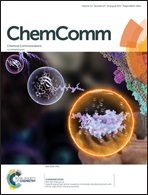Fluorescence emission originated from the H-aggregated cyanine dye with chiral gemini surfactant assemblies having a narrow absorption band and a remarkably large Stokes shift†
Abstract
We demonstrate that the fluorescence emission that originated from a cyanine dye forming H-aggregates with a narrow absorption band and a remarkably large Stokes shift can be induced by symmetry breaking. The H-aggregate formation was successfully induced using chirally assembled cationic gemini surfactants with enantiomeric tartrate counterions as templates in water.



 Please wait while we load your content...
Please wait while we load your content...